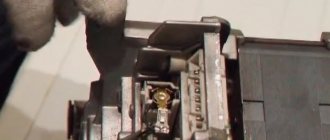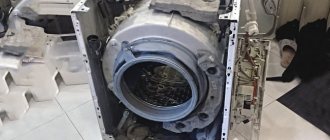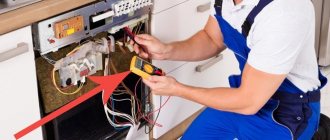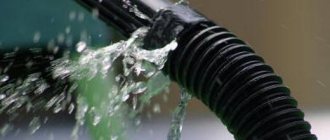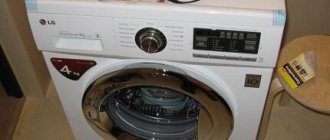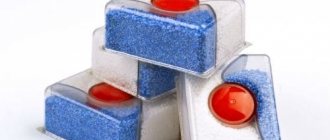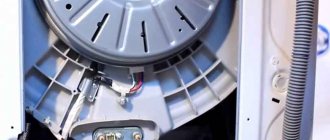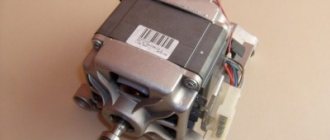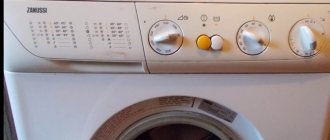When a dishwasher breaks down, it is difficult for us to understand the cause. Can I handle the repair myself or is it better to contact a professional? Our publication will help you figure it out. We will describe typical faults, as well as repair options for Hansa dishwashers. You will find out why the machine does not turn on or does not fill with water. The path to the solution is described below.
Typical problems with the Hansa PMM
To understand the reasons for the breakdown, knowledge about the principle of operation of the dishwasher will be useful. Let us briefly and clearly describe the sequence of stages:
- Loading dishes, turning on the program.
- Switching on the solenoid valve, water intake.
- Pumping water with a circulation pump through a heating element, heating it.
- Hot liquid is fed into the spray nozzles and flies out of the nozzles under pressure.
- The waste liquid goes into the drain filter, where it is cleaned and can be reused.
- After rinsing is completed, the water goes down the drain.
- Drying starts or the cycle ends.
Why does the car fail? There are several main reasons:
- Poor build quality. Manufacturing defects.
- Unstable voltage in the network, which leads to damage to electronics.
- Incorrect installation and connection of the PMM.
- Using low-quality detergents.
- Operational problems.
A common problem is blockages in the drain and fill paths. Hence the problems with collecting or draining water. Poor cleaning of dishes before loading leads to foreign objects entering the filter and pump.
What problems are typical for Hansa dishwashers? In first place, according to the service centers, was a malfunction of the pressure switch, or more precisely, its electrical part. Users also complain about the following:
- The machine does not turn on;
- Very bad at washing dishes;
- The body is electrocuted;
- Noise during operation;
- Poor supply of detergent.
In addition, error codes on the display can indicate a breakdown.
How can I fix these problems? Let's figure out in what cases you can carry out repairs yourself, and when it is better to call a specialist.
Mechanical cleaning stages
Although many modern dishwasher models have a self-cleaning function, this does not prevent the need to periodically wash the filters and other elements of the machine.
And even professional appliance care products may not be enough when it comes to blockages or operation in hard water. Therefore, the key to flawless operation of the dishwasher is comprehensive and timely care.
Washing the drain and fill filter
The drain of any dishwasher has a multi-layer filter, the purpose of which is to prevent the drain from clogging with pieces of food and other debris.
But even if you diligently follow the manufacturer’s recommendations and wipe the dishes with napkins before each load to remove food residues, grease or hard water deposits may cause the appliance to stop without completing the full wash cycle.
To get to the filter, do this:
- Turn off the dishwasher.
- We remove the lower basket and collect the remaining water at the bottom of the device with a sponge.
- In the lower part of the case, next to the sprayer, we find a round recess - a filter is placed in it, which consists of a metal membrane for fine cleaning, a plastic cup with large holes and an internal mesh.
- New dishwashers provide easy removal for this element - just pull it up or unscrew it counterclockwise. But in models older than 7-10 years, you may need a screwdriver, pliers and other improvised tools from the home craftsman’s arsenal.
- You need to remove water from the hole under the filter with a sponge and inspect the niche for contamination - if any solid particles of waste get through the filter protection, they can damage or break the pump.
- To make sure that the pump impeller is working, you can unscrew the self-tapping screw with a screwdriver, remove the protective strip and carefully turn the blades. If they rotate easily and no foreign objects are found, you can put them back together. Otherwise, you will have to disassemble the pump structure.
- Then all parts are cleaned of debris and washed with warm water and any fat-dissolving agent. If the filter has not been cleaned for a long time, the mesh cells are very clogged, or the glass is covered with scale, you can soak these elements for a couple of hours in a solution of vinegar, citric acid, or spray them with dishwasher detergent.
Although the outlet filter is the most popular place for blockages to accumulate, when performing comprehensive mechanical cleaning of the dishwasher, it doesn’t hurt to check the condition of the intake hose. Accumulations of sand, rust particles and salts may be found here.
To clean the dishwasher filler, you need to disconnect the inlet hose (and at the same time rinse it). There should be two filters inside: immediately behind the tee tap and at the entrance to the device itself.
Both meshes are removed and washed with warm water. If they are damaged or heavily clogged, they can be replaced with new ones - such consumables are inexpensive. After checking, all filters are assembled in reverse order.
Checking the condition and cleaning of the sprinklers
Another problematic element that can damage a dishwasher is the spray system. Although the water from the hose is supplied already cleared of large inclusions, small particles of sand and calcium salts easily pass through the cells of the inlet filter.
In addition, water with high hardness can damage the rubber seals on rotating rocker arms, so it is advisable to inspect their condition at least once a month.
Principle of cleaning sprayers:
- Remove the upper basket along with the rocker arm attached to it.
- Bend back the latches and remove the sprinkler blades.
- Remove the lower basket and remove the lower rocker arm - usually just turn the rocker arm counterclockwise and pull it up, holding the part in the middle.
- Inspect the condition of the seals (replace if necessary).
- Rinse the blades under running water, clean the nozzles and connecting parts.
- Reassemble the system and make sure that the sprinklers rotate without interference or effort.
The fastening of the rocker arms may differ for different models, so before the first cleaning you should check the instructions so as not to accidentally break the latches.
This video will demonstrate how to clean the nozzles on Hansa dishwasher sprayers:
Cleaning the housing and seals
It is recommended to wipe the inner walls, baskets and rubber on the door of the device dry after each start-up. But it doesn’t hurt to periodically disinfect these areas using a special product approved for use in dishwashers.
Particular attention should be paid to the joints and the area on the bottom of the door - they are almost not washed with water during washing, so food debris quickly accumulates here and begins to decompose.
If the seal is not very dirty, it is enough to wipe it with a soft cloth soaked in a cleaning solution, and in advanced cases, you can help yourself with a toothbrush. But it is not advisable to spray the product or wash the door with a wet sponge, so that the liquid does not get on the electrical wiring or in the lock.
Many housewives use home remedies to clean household appliances, for example, lemon powder or vinegar. But in the case of seals, such savings are very doubtful - the rubber may harden or dry out under the influence of acid, and the machine will begin to leak during operation.
Baskets with dried food debris can first be soaked in warm water for a couple of hours, then washed in a soapy solution with a stiff, non-metallic brush. However, the self-cleaning function also copes well with this task, if it is provided in the device. Before installing inside the box, all elements must be washed with clean running water and wiped dry.
What to do when an error code appears
When an error code appears, you need to refer to the instructions for the dishwasher to find its explanation and understand what the reason is and what exactly is wrong with the unit.
Contact VseRemont24 if:
- The instruction manual for your dishwasher “helper” is lost somewhere.
- You haven't fully understood the description of the error.
- You took independent actions to eliminate the problem, but they did not produce results.
- We realized that the dishwasher needs repairs, and you need the help of a professional and experienced technician.
Read also: Do-it-yourself winch from an angle grinder
Dishwasher malfunctions can be minor and can be fixed within a couple of minutes, but most of them require complex repairs.
Any external or internal part, as well as the entire unit of the dishwasher, can fail.
Failures of important components lead to the most common malfunctions:
- water leak,
- lack of dialing, draining water,
- no heating/overheating of water,
- insufficient amount of water,
- inconsistency of electrical network parameters with the necessary ones,
- program malfunctions,
- failure to perform individual functions or complete failure of the unit to work, and so on.
A faulty dishwasher works worse and does not wash dishes well. From a technology that saves water and electricity, it turns into an expensive “pleasure”. What is most important is that using a faulty electrical appliance is unsafe for people’s health and lives!
Some useful tips for repairs and diagnostics
By some obvious signs you can determine the area of the dishwasher that needs to be dealt with. If you carefully monitor the operation of a household appliance, malfunctions can be prevented. It is enough to carry out timely maintenance and correct even the smallest errors in operation, since small breakdowns become a springboard for major malfunctions.
- In order for the dishwasher to work properly over a long period of time, special attention should be paid to the filters. The filter element should be cleaned every few months, and if it malfunctions, replace it immediately.
- Do not add large amounts of rinse aid. This has a bad effect both on the operation of the machine and on the quality of washing - stains remain on the dishes. To comply with the norm, just look at the operating instructions for the dishwasher, and always use a measuring cup.
- All failed elements must be replaced immediately. This also applies to electric motor bearings. A bearing that makes noise during operation of the device may last for some time, but this may have a bad effect on the operation of the entire device as a whole.
- In order for dishes to be cleaned well and efficiently from food residues, they must be placed correctly in the dishwasher. If the plates are stacked one on top of the other, the bottom row will be washed worse than the top row.
- For a dishwasher, in the common electrical panel, a separate circuit breaker is installed (to prevent the consequences of a short circuit), as well as an RCD (for user safety).
- Rubber seals and components of dishwasher mechanisms have a short service life. Therefore, during inspections, special attention should be paid to them.
If you follow the above recommendations and have a reliable tool at hand, then repairing any dishwasher with your own hands will turn into an exciting and simple task.
When a dishwasher breaks down, it is difficult for us to understand the cause. Can I handle the repair myself or is it better to contact a professional? Our publication will help you figure it out. We will describe typical faults, as well as repair options for Hansa dishwashers. You will find out why the machine does not turn on or does not fill with water. The path to the solution is described below.
Two ways to reset dishwasher errors
If you have figured out the cause of the breakdown and decided on further actions, you can reset the error code.
There are two easy ways to do this:
- Disconnect the dishwasher from the power supply for 15-20 minutes. This time is enough for the control module to reset its settings and restart.
- Power on for 10-15 seconds . After this action, the equipment settings are also reset.
The recommendations described are suitable for dishwashers of different brands and models.
Our advantages
- Free consultation by phone. Based on the reasons for the malfunction you mentioned, our manager will determine the possible cause of the breakdown and the estimated cost of eliminating it. The technician will tell you the exact amount after diagnosis.
- Free visit of a technician and diagnostics. You will not have to pay for a technician to come to your home and inspect faulty equipment if you agree to further repairs by RemBytTech specialists.
- Home repairs. Our specialists will repair your dishwasher right at your home. Therefore, you don’t have to look for a way to deliver it to the workshop and waste your time on it.
- Convenient work schedule. We work from 8 to 22 hours. Therefore, we will accept and fulfill your request even late on the weekend.
- Guarantee. We confirm the quality of our work by issuing a warranty card for a period of 3 months to 2 years, depending on the complexity of the repair.
How to reset all Bosch dishwasher errors
One of the most popular in our country, the German manufacturer of household appliances Bosch, has provided for immediately resetting all previously accumulated errors in its units.
To reset the accumulated errors of the Bosch dishwasher and reboot it completely, you need to:
- Open the unit door.
- Start the “Power on” button.
- Press the 1st and 3rd program buttons at the same time. Hold for 3 seconds.
- Close the door and open it again.
- Start the Reset button. Hold for 3 seconds.
- Close the door and wait for the signal to finish washing.
- Open the door. Turn off the car.
If you doubt the correctness of the actions taken, and do not want to once again expose yourself and the equipment that is irreplaceable in everyday life to risks, contact VseRemont24!
A certified technician will repair a dishwasher of any make and model, no matter what kind of damage occurs to it!
How to reset all errors on Bosch SPS40E12RU (rotary mode switch)?
Adding a solution
It is forbidden to write answers that do not bring any benefit to the questioner from the series: “take it to the service center”, “contact the ASC”, “unprofitable”, etc. Such answers will be considered a rating increase, the answers will be deleted, and the account will be blocked.
If you undertake to help people, answer fully. Explain why, if you recommend, for example, to reflash the phone, then write how to do it. If you write that repairs are unprofitable, explain why.
Adding answers that essentially repeat existing answers on this issue will also be considered cheating.
Removing grease, mold and scale
If you notice that a whitish coating has appeared on the dishes or the inner walls of the appliance, or an unpleasant odor begins to emanate from the box, you need to urgently start cleaning the machine.
And the best helpers here will be ready-made solutions made by machine manufacturers. The means at hand, which are likely to be found in the kitchen of any housewife, will also come in handy.
Use of ready-made chemicals
To wash the dishwasher and its internal elements that are inaccessible to simple mechanical cleaning, it is recommended to run the device on any long cycle at high temperature with the addition of a cleaning agent.
But if you notice yellow or rusty spots on the inner surfaces of the dishwasher, the cause may also be a high iron content in the water. In this case, you will have to install a special filter on the inlet hose.
Fresh stains can be removed with a rag soaked in stainless steel cleaner, but old rust is best treated with an anti-corrosion coating after washing.
The most popular chemicals for disinfection and descaling:
- Finish Machine Cleaner - under the influence of hot water, the membrane on the neck of the bottle dissolves, and the product actively cleans all accessible surfaces from grease, scale and unpleasant odors.
- Antiscale - degreasing powder for removing lime deposits and scale on the internal elements of the machine.
- FILTERO is a liquid for the preventive cleaning of dishwashers from grease and scale.
- ELECTROLUX is a liquid product for removing fat deposits and small food debris, as well as anti-scale powder and flavoring.
These drugs work on a similar principle - they are placed in an empty dishwasher, then the device is turned on for 45-90 minutes at high temperature. Afterwards, it is recommended to run the rinsing again dry, for a short cycle, to ensure that all chemical residues are removed, and wipe the surfaces dry with a soft cloth.
In addition, you can use specialized sprays and liquids recommended for cleaning and polishing the stainless walls of the dishwasher, and to combat unpleasant odors - flavors that are hung on the baskets of the device and can be used over several cycles.
But manufacturers do not recommend adding dishwashing liquid for preventative washing and degreasing of the surface.
The fact is that increased foaming can damage the internal elements of the device, and attempts to save money will end in repairs. Therefore, it is possible and necessary to manually wipe surfaces in a soap solution, but you should not run the machine with the addition of a foaming liquid.
Alternative to purchased products
Professional preparations are good for their balanced composition and complex effect on the three most common problems of machines - scale, odor and grease deposits. But if you are looking for a way to quickly clean your dishwasher and save money at the same time, we offer several recipes using inexpensive but effective ingredients.
To clean the machine, and at the same time the drain from fatty deposits, you need to pour 1.5-2 cups of vinegar into a cup or plate. Then they should be placed in the upper tray, soda should be poured on the bottom and any long mode should be started.
And as soon as the water heats up, press pause and leave the device for at least 30 minutes (but preferably overnight). During this time, various dried debris and plaque will soften and can be easily removed along with dirty water.
Another universal remedy that will help remove traces of scale is citric acid. Its consumption depends on the displacement of the car and the degree of contamination, but on average you will need about 150-200 grams. It also works at high temperatures, and for better effect - with a forced stop of the device from 30 minutes to several hours.
There is also a more gentle way - prepare a solution from water and vinegar or lemon powder, pour it into any bottle with a spray bottle and use it to manually clean the inner walls of the box and other surfaces with scale. In this case, you need to spray the product carefully and make sure that it does not get on the rubber elements or on the skin.
You can make “2 in 1” tablets from soda, which will not only help clean your car from grease and dirt, but also refresh the air with a pleasant aroma.
- Pour 10-15 drops of any essential oil and 1-2 tablespoons of hydrogen peroxide into a glass with powdered soda.
- Mix everything with a spatula - the mixture should look like wet sand.
- Using an ice cream spoon or scoop, form small balls.
- Place the prepared tablets on the bottom of the device.
- Run the dishwasher on a long cycle.
For the best effect, users recommend placing a plate with 1-2 glasses of vinegar in the basket.
Some types of faults
Dishwashers often leak due to the use of low-quality detergent. Some products provoke the formation of a large amount of foam. It, in turn, leaks through even the best seals.
Some models of devices produced by the brands Candy, Indesit, Bosch, Veko and Siemens may experience difficulties in functioning due to incorrect direction of the jets. In this case, the dishwasher is leaking due to intense splashing past the door. Liquid accumulates at the bottom. It is recommended to check for such problems first. It would be a good idea to check the door seal. It is worth clearing this part from accumulation:
- fat particles;
- detergent residue;
- traces of dirt and grains of food.
Most common problems
How can faults appear? Often, a dishwasher leak is not a huge puddle that has formed under the door of the device. Sometimes the problem manifests itself:
- in the form of a few drops of water on the floor after completing the appliance washing cycle;
- as natural condensation remaining from water vapor on the equipment door, respectively, drops after opening it drain onto the floor near the device;
- moisture formation under equipment.
Each of the problems is completely solvable. By the way, a few drops of moisture near the dishwasher are most often a manifestation of another problem - condensation. When you open the door of the device, they simply fall onto the floor covering. How to solve this issue? Everything is quite simple here. In this situation, it cannot be said that the equipment is leaking. Another thing is that moisture constantly accumulates below, on the surface of the equipment. Experts recommend avoiding opening the device immediately after the machine is finished operating. It is necessary to wait for the condensate to evaporate. Also, drops formed during operation can always be wiped with a dry mop, cotton cloth or regular towel.
